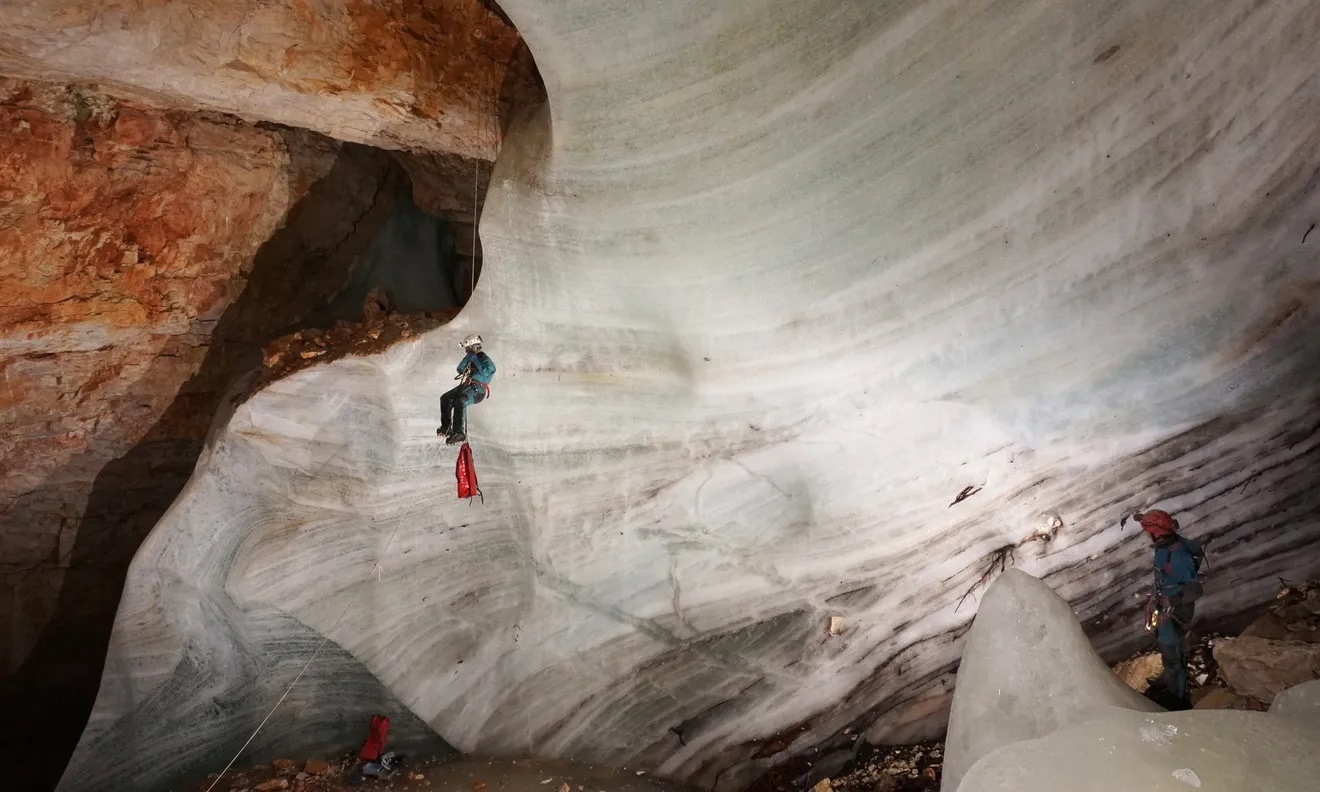Reviewed by Mila PereraSep 9 2022
For the first time, a group of geologists from the University of Innsbruck has expansively recorded the gain and loss of ice in Alpine ice caves across the last 2,000 years. They closely examined eight ice caves in four Austrian federal states.
 Charlotte Honiat and Tanguy Racine from the Department of Geology pack ice samples in the Tyrolean Guffert Eisschacht for further analysis in the laboratory. Image Credit: University of Innsbruck.
Charlotte Honiat and Tanguy Racine from the Department of Geology pack ice samples in the Tyrolean Guffert Eisschacht for further analysis in the laboratory. Image Credit: University of Innsbruck.
Tanguy Racine, a geologist, cautions that ice found in smaller caves is in particular danger of vanishing soon and, along with it, a substantial climate archive. Details of the research can be found in the journal Scientific Reports.
There are many thousand identified ice caves worldwide, and Austria is one of the nations with the maximum density of ice caves — but only some have been explored in detail. In the last few years, a group of scientists from the Universities of Innsbruck and Belfast has comprehensively examined eight ice caves with a descending morphology in Styria, Tyrol, Carinthia, and Upper Austria, taking a comparative research method.
There are already some good studies on single ice caves. However, this was the first time a comparative analysis was carried out and we focused on the ice development in several caves that are also in comparable settings: similar altitude and a steep to vertically sloping geometry.
Tanguy Racine, Geologist, Quaternary Research Group, Department of Geology, University of Innsbruck
Christoph Spötl heads the Quaternary Research Group.
His dissertation handled the subject in detail. Ice bodies in these caves are shaped from solid precipitation: in winter, the snow falls, slips into the cave, and changes to ice at low temperatures.
Similar Development of Ice Caves and Glaciers
Applying the radiocarbon technique, the researchers established the age of the ice layers in the caves, which are frequently many meters in thickness.
“To date the ice, we focused on the tiniest inclusions of wood in the ice layers. The age of these wood fragments, which fell into the caves from the outside, can be determined precisely,” Tanguy Racine elucidates the process.
The large database of a total of 107 dates of wood inclusions from the ice draws a reliable image of the gain and loss of ice in the cave — the so-called mass balance — spanning a period of nearly 2,000 years. This method allowed the researchers to confirm the hypothesis that historically recorded glacier advances, such as during the “Little Ice Age,” are also illustrated in the ice mass increase in ice caves and coincide in time.
We can document comparable ups and downs in the development of ice in ice caves and glaciers for the period of the last two millennia. For both, it is essential how much snow falls in winter and how warm the summers are. The results also show us that a large part of the underground ice in Austria originates from the ‘Little Ice Age’ between about the 15th and 19th centuries.
Tanguy Racine, Geologist, Quaternary Research Group, Department of Geology, University of Innsbruck
Massive Declines in Recent Decades
In the last few years, the balance of ice caves has been evidently negative.
“Glaciers are not alone in showing an above-average negative mass balance especially in the last decades. Ice caves have also been severely affected by the consequences of rising temperatures and declining precipitation,” says Tanguy Racine.
We are seeing a rate of ice retreat that has not been observed in any period in our measurement period over the last 2000 years. To give a few examples: Monitoring in the Guffert Eisschacht in Steinberg am Rofan showed a decline of almost three meters in the snow surface between 2019 and 2021, while Eisgruben Eishöhle at Sarstein in Upper Austria has lost 10 meters of ice thickness within 40 years. The ice loss in Kraterschacht in the Sengsen Mountains of Upper Austria is 20 meters in 20 years.
Tanguy Racine, Geologist, Quaternary Research Group, Department of Geology, University of Innsbruck
The reason for this development, comparable to the glaciers, is human-triggered climate change.
Racine continues, "Especially for the medium-sized and smaller ice caves, we have to assume that they will massively lose ice mass or even become completely ice-free in the next few years to decades. The clock is ticking loudly."
The Innsbruck team is planning to selectively procure ice cores from alpine ice caves in the coming years and keep them in cooled condition to safeguard the treasured climate information for future science.
Journal Reference:
Racine, T. M. F., et al. (2022) Multi-centennial mass balance of perennial ice deposits in Alpine caves mirrors the evolution of glaciers during the Late Holocene. Scientific Reports. doi.org/10.1038/s41598-022-15516-9.